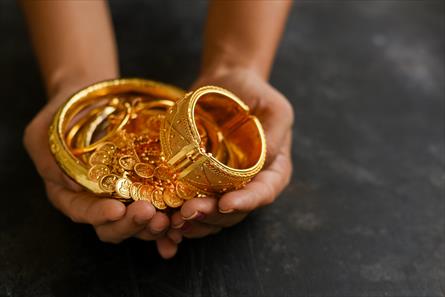Identifying Fake Gold: Metals that Look like Gold but Aren’t
While the majority of gold purchases are accurate, some sellers may deceive buyers with fake materials. Dealers could also unintentionally sell fake materials on the market in situations where they’re unable to differentiate between various precious metals. Knowing the main features of gold, besides its color, can help you save time and money. The precious metals experts from First National Bullion and Coin, San Diego collectors’ top choice for the best place to buy gold in San Diego, offer a few tips to help you avoid costly mistakes when making purchases.
Iron Pyrite
In many cases, this mineral is referred to as “fool’s gold” because of the yellow luster that makes it resemble gold. This is due to the mineral being made with a mixture of iron and sulfur. Both iron pyrite and gold will shimmer in sunlight, but due to the metallic luster in iron pyrite, its shine won’t retain its color as well as gold when in direct light. The mineral doesn’t melt down, unlike gold, but again, its yellow luster is often mistaken for gold. Pyrite, unlike gold, is often valueless and should be avoided when building your collection.
Copper Alloy
The form of brass is what makes these metals similar. Alloy is a mixture of zinc and copper and resembles the appearance of gold closely. The positively charged metal atoms are often in fixed positions and surrounded by delocalized electrons that result in both copper alloy and gold being yellowish or orange. However, just because the precious metal glitters doesn’t mean it’s gold.
When it comes to gold jewelry, which is often mistaken the most, less intensely colored coatings are used for the copper alloy, resembling gold. Although dealers do this intentionally, it can be deciphered with accurate testing.
Tungsten
IG plating is a process that can make gold and tungsten bars or jewelry seem similar. The metals are also alike in terms of weight. However, the bands of tungsten are much harder than gold and won’t scratch as easily. Gold plating is often so thin that it can scratch with ease, which allows buyers to find the fake cores in tungsten bars.
Although tungsten is a natural silver and gray color, it can be finished in many appearances, with rose gold being one. This makes it easy to be passed off as gold, especially when used in rings and bars.
How to Avoid the Fakes
By understanding gold’s malleability, density, and resistance to rusting and tarnishing, you can avoid being deceived into purchasing materials that resemble but aren’t truly gold. A trustworthy boutique should check and authenticate all the gold they sell, especially secondary products. Authenticity checks for precious metals and minerals can lower the risk of buyers receiving fake bullion, jewelry, and more.
A magnetic test is always good to incorporate, as pure products will attract when it comes to using a reasonably strong magnet. An alternative method is the float test, which requires placing the gold in a bowl or glass of water. If the product doesn’t immediately sink to the bottom of the container, it’s impure and fake, as real gold is heavy.
Incorporating these methods can help you avoid investing in counterfeit gold and getting scammed. Whether they’re looking to buy or sell palladium bars, silver bullion, or gold coins, San Diego residents can trust the reputable dealers at First National Bullion and Coin. You can rely on our experienced professionals when you’re looking to add precious metals to your investment portfolio. Call one of our precious metals experts today.
The statements made in this blog are opinions, and past performance is not indicative of future returns. Precious metals, like all investments, carry risk. Precious metals and coins may appreciate, depreciate, or stay the same in cash value depending on a variety of factors. First National Bullion does not guarantee, and its website and employees make no representation, that any metals for sale will appreciate sufficiently to earn the customers a profit. The decision to buy, sell, or borrow precious metals and which precious metals to purchase, borrow, or sell are made at the customer’s sole discretion.


